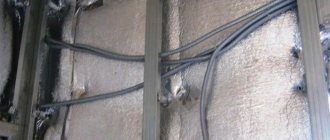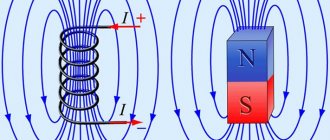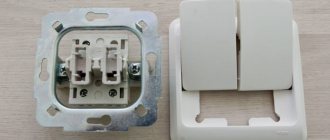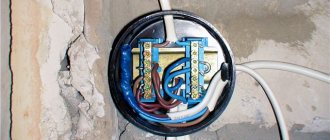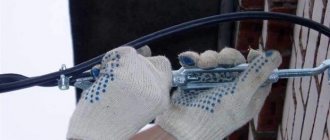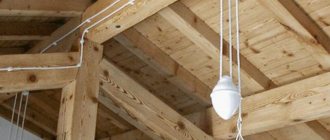When many people hear the word electrical wiring, they associate it with sockets, switches and carriers. In fact, it is a complex system that includes a much larger number of different components. Including those related to fastening. Let's take a closer look at what constitutes hidden and open wiring. We will also analyze the difference between installation work.
Decorative open-type electrical wiring Source onduline.ru
A few words about electrical wiring
The purpose of electrical wiring is the transmission and distribution of electricity from the power source to each end consumer. This statement is true both for a single apartment and for an entire enterprise. In the latter case, the power source will be an electricity-generating station, and the wiring will be a power transmission line (PTL).
In a private house (apartment), the electric meter is used as the basis. It is from this that the current runs through the wires to the lighting lamps and sockets with connected household appliances. According to the above, all electrical wiring can be divided into two types. Laid indoors and running outside buildings.
But in both cases, the wires are laid in two ways. They can either be completely hidden from view or left on public display. Both open wiring in the interior of an apartment and its hidden counterpart, both have certain installation requirements.
General provisions on regulatory documents for electrical wiring inside the house:
- Each cable of any wiring must have a strict position on the wall. Either horizontal or vertical.
Strictly horizontal and vertical arrangement of wires Source rusenergetics.ru
- Wires or sockets should not be closer than 50 cm to metal pipes, gas stoves and any heating appliances.
- The wire in a horizontal plane should be located at a distance of no closer than 1-1.5 meters from the ceiling or floor.
- There must be at least one meter from corners, window and door openings to wiring running in a vertical plane.
- Connection of conductors is possible only in junction boxes.
- The cable cores are either welded (soldered) to each other or crimped.
- All sockets, switches, and boxes should be located in convenient places for easy access.
- For bathrooms, the installation of one socket with additional insulation is allowed.
- It is always necessary to use a device for feeding cables into the wall in the form of a piece of hollow pipe when you need to route the wiring to another room.
Security measures
Making mistakes when installing open wiring creates the preconditions for emergency situations to occur during the operation of the home electrical network.
Layout of elements
Main causes of fires:
- weakening, oxidation of contacts;
- insulation damage;
- use of cable with copper and aluminum conductors;
- laying on a flammable base;
- the wire cross-section does not correspond to the load;
- the panel contains automatic circuit breakers with a higher permissible limit (current) than that of the cable;
- faulty sockets.
RCD connection diagram
To avoid fire, use a cable with a reserve cross-section. On combustible bases, conductors are laid on a gasket made of non-combustible materials. An RCD is installed in the panel for each group of loads.
Thus, open wiring has a number of advantages: it is inexpensive, quick to install, and lasts a long time. However, it is not suitable for everyone, because wires on the walls do not fit into many interior styles.
Open wiring
In colloquial use, wires that are not hidden in the walls are called external or external wiring. This is true, but technically not entirely accurate. This also applies to the claim that internal wiring is routed behind a surface. And to understand all the terms, you need to know the exact definitions of each.
Open type wiring Source remontnik.ru
Open electrical wiring is an option for placing current-carrying wires when they either remain completely visible or are partially hidden behind decorative devices. That is, all conductors are not buried in the thickness of building structures (walls, ceilings, floors), but run along their surface. This method is considered the simplest and is therefore considered budget-friendly.
External (open) wiring has three subtypes:
- Stationary. Connected on a permanent basis.
- Portable. Uses plug connectors to enable operation.
- Mobile. Necessary for providing electricity to mobile mechanisms.
A striking example of portable open wiring is ordinary household extension cords. And the mobile one has a long cord from a vacuum cleaner.
Open electrical wiring has many installation methods:
- freely suspended from the ceiling;
- fixed to the surface with brackets;
- inside the electrical baseboard;
- on strings, cables or rollers;
- in a corrugated sleeve;
- on insulators;
- in platbands, boxes or pipes.
Electrical wiring hidden in pipes Source esoligorsk.by
The main advantage of open wiring is that anyone who is familiar with electricity only from the school curriculum can install it. In addition, this does not require any special tools. And there is no need to violate the integrity of walls or ceilings.
In working condition, the wiring is always available for inspection and repair. And if you need to move the outlet to another location, then this is very easy to do. The same applies to connecting new lamps or household appliances to the network.
But the disadvantages are also quite serious. Firstly, this wiring method is not suitable for every room (there are technical standards). Secondly, if the load on the network is allowed to exceed, then overheating of the conductors occurs in problematic areas. This could result in a fire in the premises.
Well, not every interior can fit it properly. Because electrical wires on public display look unattractive.
Wiring in retro style Source stroikairemont.com
See also: https://m-strana.ru/brands/elektrotekhnicheskie-raboty/
What cables and wires are laid in pipes (requirements of the PUE)
The current regulations do not impose any special requirements on the type of wires and cables pulled in metal pipes. In accordance with clause 2.3.42. PUE this method of laying is acceptable for the following types:
- cable products in rubber or plastic insulation;
- the same types of cables that do not have additional protection (its function is performed by the walls of pipe blanks);
- cable products with a large number of sheaths.
Please note: According to the PUE, the presence of an additional protective coating does not exclude the need to use steel pipes.
When laying 3-phase power lines based on a four-core cable, the body of a steel pipeline can be used as a neutral conductor. This assumption is valid only if their walls are continuous throughout the entire route. When choosing material for pipe blanks, the following varieties can be used:
- metal (cast iron, steel) products;
- asbestos-cement pipes;
- concrete and ceramic analogues.
The option of using plastic products cannot be ruled out. The choice of a specific type of material is determined by a number of factors, the main of which are the proximity of groundwater, contact with aggressive environments and the presence of stray currents.
Hidden wiring
Sometimes you can hear the expression internal wiring. But it should be said more precisely and correctly - hidden electrical wiring. With this method, all conductors are walled up in the walls or ceiling. They can be hidden either behind a layer of plaster or behind plasterboard panels. Only sockets and switches, as well as lamp sockets and junction boxes remain visible.
Installation of hidden wiring is carried out in:
- furrow for plaster;
- flexible corrugated sleeve;
- voids of building structures;
- pipes, channels and boxes;
- niches under plasterboard structures.
The safety of such wiring is quite high. Both in terms of fires and the inability to touch live parts. Moreover, the service life is much longer than that of an open analogue. In addition, it does not spoil the appearance.
But installing hidden wiring is quite labor-intensive. In addition, without an accurate wire layout, the possibility of repairing the line is reduced to almost zero. You will also definitely need a plan when you need to make a hole in the wall. Otherwise, you may get caught in the cable and receive an electric shock.
Installation of hidden electrical wiring Source amperof.ru
External wiring
This type of laying of conductors for electricity is often called street laying. And in this case, external wiring is considered already in the interior of the yard. It runs from the outside of the building and is needed to provide electricity to the utility rooms. And also for powering alarm systems and CCTV cameras.
It is also necessary to ensure normal lighting of the entire area at night. Therefore, installation of external electrical wiring often takes place along special supports leading to street lamps. Otherwise, the wires are laid along the walls of buildings. And in this case, the wiring can be either open or hidden.
The main difference between external electrical wiring and internal wiring is that the wires are exposed to literally all atmospheric aggression. From winds and scorching sun to all precipitation and frost. Therefore, the insulation of conductors needs to be very reliable. Safety for others depends on this.
Wiring for street lighting Source mobilevideoguard.com
Installation of open electrical wiring
If the wiring method is chosen to decorate the room in a retro style, then ceramic insulators are purchased. They are attached to the wall and wires twisted into pigtails are hung on them. When simple and practical goals are pursued, the technology for installing open electrical wiring is performed in one of three popular ways.
On staples
The most budget option, since its cost is the lowest of all. The brackets allow you to attach the wire directly to the wall if its thickness does not exceed 6 mm. But it should not be less than 1.5 mm. In this case, all sockets and switches are installed first. Then they are connected with wires.
In the pipes
There are quite a few types of special electrical pipes. From metal to plastic. But the most popular is corrugated products. All types perfectly protect wires from mechanical damage, as well as from fires.
Installation of wires in an open way Source tools.ru
The method, like the previous one, is not very aesthetic. Therefore, it is well suited for technical or utility rooms. Modern flexible corrugation is equipped with a special probe. This is a thin wire, the cable clings to one end of which, and the other is pulled, pulling the wire through the pipe.
Special clips are best suited for wall mounting. They are attached to the surface at a certain calculated interval. And pipes with cables are already inserted into them. This method is convenient because in case of dismantling it is enough to pull the pipe. And it comes off easily from the clips.
Advantages and disadvantages of this method
There are several known methods of laying cables, which are fundamentally different from the option considered here. Therefore, it is important to understand what the advantages of installing electrical wiring in pipes . Its advantages include the following features:
Pros and cons of electrical wiring in pipes
The wiring is reliably protected from linear stretching, strong compression, as well as from kinks and punctures.
In the event of an accidental fire in the room, the wires will not be damaged.
With such protection, sun rays and atmospheric influences are not dangerous for cable insulation.
When choosing the installation option in metal pipes, the cost of work and materials increases sharply.
Electrical cables laid in them are not at risk of compressive loads that occur during surface deformations or during shrinkage of newly built buildings.
Installation of hidden electrical wiring
To remove wires from sight, as well as to increase the safety of using electricity, it is necessary to shingle the walls. But first you need to drill holes for the socket boxes. To do this, put a special diamond-coated bit with a diameter of 72 mm on the drill.
When all the places for switches and sockets are prepared, grooves are laid between them. This is a groove in concrete or brick into which the electrical cable is then laid. The easiest way to make a recess in a solid wall is with a wall chaser. But you can replace it with a regular grinder with a diamond wheel.
In this case, two parallel grooves are cut, and the concrete between them is removed using a hammer drill. Next, the electrical cable is laid in the grooves. To prevent it from falling out of the grooves, it is fixed in several places with gypsum plaster.
Wires are connected to sockets and switches. After this, they are connected in a junction box. Next, the control line is switched on. If everything is in order, proceed to plastering the grooves.
Connecting wires
When cables are inserted into the distribution block, the main insulating material splits, freeing the cores. Each individual group is connected using clamps. Approximately 15-20 mm of insulation is removed from all conductors. The crimping or soldering method is ideal for connecting copper cables. After this, the wiring is neatly placed in the box. Connection blocks must be hermetically sealed to prevent metal corrosion. It is necessary to thoroughly approach the grounding of all common structural elements without breaking the circuit.
External electrical wiring is easy to install and maintain; using a variety of products, you can achieve an attractive appearance. However, compared to hidden wiring, it is less safe. If there are small children in the house, then the cables must be laid in hard-to-reach places, for example along the ceiling, or carefully hidden in special devices.
Briefly about the main thing
When laying electrical wiring in a residential building, you first need to decide on the method. Hidden wiring looks more aesthetically pleasing. Because it is not visible at all, and it does not disturb the interior of the room.
But its implementation is very labor-intensive and without a special tool it will be extremely difficult to make channels in a concrete wall. Therefore, when aesthetics can be neglected, many choose open-type wiring. And when decorating a room in a retro style, it will become an indispensable attribute.
